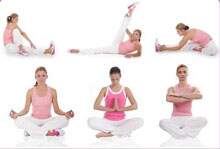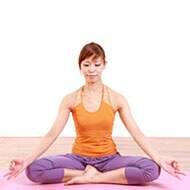- Raja yoga
- Yoga Stretches
- Jivamukti Yoga Poses
- Yoga Tree Pose
- Sun and Moon Yoga
- Wind Removing Pose
- Hare Pose
- Accomplished Pose
- Urdhva Mukha Pinch Mayurasana
- Revolved Abdomen Pose
- Raised Foot Pose
- Scorpion Pose
- Butterfly Pose
- Half Tortoise Pose
- Revolved Twist
- Balancing Stick Pose
- Cat Pose
- Supported Shoulderstand
- Crane Pose
- Handstand
- Happy Baby Pose
- Firefly Pose
- Scale Pose
- Side Plank Pose
- Upward Facing Two-Foot Staff Pose
- Reclining Big Toe Pose
- Stick Pose
- Revolved Head-to-Knee Pose
- Full Boat Pose
- Upward Extended Feet Pose
- Yoga arm balance poses
- Core Yoga
- Inversion Yoga Poses
- Seated And Twist Yoga
- Horse Pose
- Cobbler Pose
- Seated Wide Angle Pose
- The Compass Pose
- Half Crow Pose
- Bound Half Moon Pose
- Lotus Pose
- Fixed Firm Pose
- Back-bend Poses
- Forward bend Poses
- Sarvangasana
- Ashtanga Yoga Poses
- Warm up poses
- Seated Poses
- Seated Forward Bends
- Chair Poses
- Standing Poses
- Standing Balancing poses
- Yoga Asanas
- Hatha Yoga Asanas
- Yoga Postures Online
- Partner Yoga Poses
- Anusara Yoga Poses
- Advanced Yoga poses
- Restorative Yoga Poses
- Kids Yoga Poses
- Beginning Yoga Postures
Reverse Warrior Pose - Viparita Virabhadrasana
Yoga is considered to be a science of consciousness. Through this integrated system of various techniques, we can develop the potential that is hidden inside of us.
Our qualities of awareness, higher abilities, intuition, intelligence, discrimination, confidence, security, joy, and love expand with our practice of yoga. This is the main application of this ancient system.
However, today, yoga is more popular as a method of treating different disorders and getting fit. The Reverse Warrior yoga pose or Viparita Virabhadrasana is a standing pose that provides a stretch to the waist and energizes the entire body. It is normally performed in the classes of vinyasa flow as part of a sequence of the ‘dancing warrior’, which goes from Warrior I (Virabhadrasana I) to Warrior II (Virabhadrasana II) and then to Reverse Warrior Pose. This is the reason why Reverse Warrior is sometimes called ‘Dancing Warrior’. This pose gets its name from a mythological Hindu warrior Virabhadra. Virabhadra was fierce, dark, and tall, depicted with a garland of skulls, flaming eyes and hair and a thousand arms. ‘Viparita’ is a Sanskrit word which means ‘reverse’.
Steps
The Reverse Warrior Pose steps are as follows:
- To perform the Reverse Warrior Pose, you should first come to Tadasana (Mountain Pose). Stand with your feet at the distance of your hips and keep your arms at the sides of your body. Then, turn left and keep your feet around 4–5 feet apart. Keep your heels aligned.
- Turn your right foot to a 90 degree angle so that your toes point to the top of the mat. Let your left foot be pivoted slightly inwards. Your left foot’s toes should be at an angle of 45 degrees.
- Lift your arms to shoulder height so that they are parallel to the ground. Align your arms to come just above your legs.
- Breathe out as you bend the knee that is in front. Your knee should be aligned just above the ankle of the foot that is in front. Keep your front shin perpendicular to the ground. Bring your hips low and your front thigh to come parallel to the ground. This is the posture of Warrior II.
- When you breathe out, lower your left hand behind your left thigh. When you breathe in, raise your arm straight up and reach your fingers to the ceiling. Keep your right bicep next to your right ear.
- Let your front knee remain bent and your hips brought low as you lengthen through the sides of your waist. Bring your back hand down your leg and your body into a slight backbend.
- Turn your head a little and keep your gaze at the fingertips of your right hand.
- Relax your shoulders, lift your chest, and lengthen the sides of your waist. Remain in this position for 10–20 breaths.
- To get out of the pose, breathe in as you lower your arms to return to Warrior II.
Through your back foot, press down and make your front leg straight. Lower your arms completely. Then. turn to the left and reverse the position of your feet. Repeat it for the same duration of time on the opposite side.
Precautions
Reverse Warrior Pose precautions include:
- Avoid this pose if you suffer from a chronic or recent injury to the shoulders, back or hip.
- Also refrain from practicing this pose if you experience high blood pressure or diarrhea.
- If you suffer from a neck injury, avoid tilting the head back in the pose. However, your gaze should be kept forward.
Remember to always work within your limitations and abilities. Consult your doctor before practicing the pose if you have any medical concerns.
Beginner’s Tip
There are a few beginner’s tips you could follow to perform the Reverse Warrior Pose correctly. It is essential that you remain focused on the different points of alignment. A good beginner’s tip is to work on getting the leg and feet placements first. Let the pose be built from the ground upwards. Make sure that your front knee remains aligned with the ankle that is in front. Prevent the knee from drifting to the inside. This can cause a strain in the joint of the knees. Your front shin should be kept vertical. Increase your stance as required to ensure that your knees do not move in front past your ankle. You should also keep in mind that it is not necessary for you to go too far in the backbend. If you feel a collapse or crunching in your lower back get out of the backbend immediately to regain the space in the spine.
Benefits to Body Parts
The Reverse Warrior Pose benefits to body parts include the following:
- Strengthens the legs
- Improves the flexibility of the spine, ankles and inner thighs
- Stretches the groin, hips and thighs
- Builds strength of the lower body
- Increases blood circulation throughout the body
- Relieves lower back pain
Therapeutic Applications
The Reverse Warrior Pose therapeutic applications include the following:
- Reduces fatigue
- Calms the mind
Variations
The Reverse Warrior Pose is an excellent way to increase the flexibility of the spine and prepare the body for other poses though your practice. Always remember to go slow and never overexert yourself to perform a deeper backbend. You could attempt some simple variations that suit you best.
- If there is tightness in your hips, you could make your stance shorter and straighten the leg that is in front to a comfortable degree.
- If you have an injury to the shoulder or you are still building the strength of your upper body, you could keep your hands on your hips. Work on lengthening your spine and lifting your chest without overexerting your shoulders and arms.
Preparatory Poses
As mentioned earlier, the Reverse Warrior Pose is usually practiced in a sequence. The poses that come before it are
- Warrior I
- Warrior II
Performing the Reverse Warrior pose can be a fun way to add grace, power and strength to your daily routine.
 Find Pose
Find Pose

